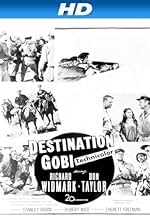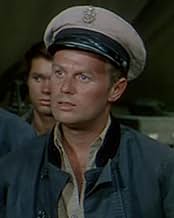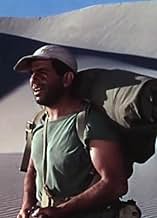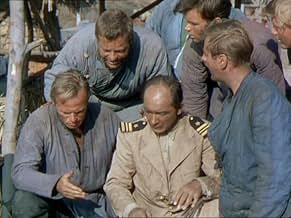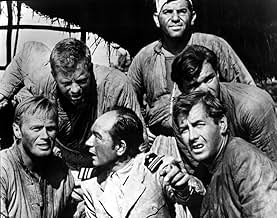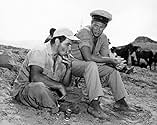ÉVALUATION IMDb
6,3/10
1,2 k
MA NOTE
Ajouter une intrigue dans votre langueIn 1944, US Navy specialists run a weather station in the Gobi desert where they are harassed by Japanese warplanes but aided by local Mongol nomads.In 1944, US Navy specialists run a weather station in the Gobi desert where they are harassed by Japanese warplanes but aided by local Mongol nomads.In 1944, US Navy specialists run a weather station in the Gobi desert where they are harassed by Japanese warplanes but aided by local Mongol nomads.
Max Showalter
- Walter Landers
- (as Casey Adams)
Edgar Barrier
- Yin Tang
- (uncredited)
Willis Bouchey
- Capt. Gates
- (uncredited)
James Conaty
- Admiral
- (uncredited)
Franklyn Farnum
- Quartermaster General
- (uncredited)
John Hedloe
- Pilot
- (uncredited)
Earl Holliman
- Frank Swenson
- (uncredited)
Frank Iwanaga
- Lieutenant
- (uncredited)
Avis en vedette
Destination Gobi is directed by Robert Wise and written by Everett Freeman. It stars Richard Widmark, Don Taylor, Casey Adams & Murvyn Vye.
"In the Navy records in Washington, there is an obscure entry reading 'Saddles for Gobi.' This film is based on the story behind that entry--one of the strangest stories of World War II."
An odd story makes for an oddly entertaining yarn as Widmark and co troop across the Gobi Desert after a Japanese air attack on their weather station base. Other problems exist too, as the Mongol tribe they have befriended may not actually be friends. Poor Widmark, he's a Navy man out in the desert and the motley crew under his command are getting rather restless.
Amazingly based on a true incident, tho we can safely assume there's much poetic license used by the makers, Destination Gobi has a nice blend of action, drama, adventure and comedy. The cast work well as a unit and run with the oddity of the plot, while Wise directs with customary assuredness. It's not one you would sit thru too often once viewed for the first time, but while it's on it's never less than engaging . 6.5/10
"In the Navy records in Washington, there is an obscure entry reading 'Saddles for Gobi.' This film is based on the story behind that entry--one of the strangest stories of World War II."
An odd story makes for an oddly entertaining yarn as Widmark and co troop across the Gobi Desert after a Japanese air attack on their weather station base. Other problems exist too, as the Mongol tribe they have befriended may not actually be friends. Poor Widmark, he's a Navy man out in the desert and the motley crew under his command are getting rather restless.
Amazingly based on a true incident, tho we can safely assume there's much poetic license used by the makers, Destination Gobi has a nice blend of action, drama, adventure and comedy. The cast work well as a unit and run with the oddity of the plot, while Wise directs with customary assuredness. It's not one you would sit thru too often once viewed for the first time, but while it's on it's never less than engaging . 6.5/10
While supposedly presenting “one of the strangest stories of WWII” (denoted in historical records merely by the cryptic phrase “Saddles For Gobi” – explained later), this film hardly constitutes the most engrossing or exciting war adventure to be depicted on the screen…and, besides, emerges as an even greater disappointment coming from a director of Wise’s stature! That said, the unusual desert location and attractive color cinematography makes it a pleasant – if forgettable – actioner. Apart from this, the fact that it’s one of Wise’s (and star Richard Widmark’s) rarest efforts, has made me leap at the chance of acquiring a copy of it (albeit an imperfect one, given the alarmingly frequent jerkiness of the image) – gleaned from a broadcast on French Satellite TV! – particularly in view of Widmark’s recent passing.
The interesting thing here is that, what starts off as a routine mission involving U.S. Navy personnel operating in a desert weather station, develops into a story of survival – as, following an aerial attack by the Japanese, the remaining members of the outfit trek towards the sea in an attempt to reach the Navy base on duty at Okinawa. Ironically, both the studio (Fox) and the star involved had already made a film about that campaign – Lewis Milestone’s HALLS OF MONTEZUMA (1950), which I’d watched on Italian TV but may check out again now (on DVD-R) as part of my ongoing Widmark tribute.
Amidst the typical camaraderie, the men suffer the elements, manage an unexpected alliance with a horde of Mongols (achieved by procuring the latter with saddles for their horses requisitioned from the U.S.!), are conned by a shady camel merchant, apparently betrayed to the Japanese forces by the Mongols themselves (though it transpires that the latter’s internment camp is actually close to the seashore) and then fight off the enemy on a ramshackle river boat. In the end, it’s certainly watchable and efficiently enough handled – but, as I said, the material per se isn’t inspiring enough to bring out the best from the talents involved…
The interesting thing here is that, what starts off as a routine mission involving U.S. Navy personnel operating in a desert weather station, develops into a story of survival – as, following an aerial attack by the Japanese, the remaining members of the outfit trek towards the sea in an attempt to reach the Navy base on duty at Okinawa. Ironically, both the studio (Fox) and the star involved had already made a film about that campaign – Lewis Milestone’s HALLS OF MONTEZUMA (1950), which I’d watched on Italian TV but may check out again now (on DVD-R) as part of my ongoing Widmark tribute.
Amidst the typical camaraderie, the men suffer the elements, manage an unexpected alliance with a horde of Mongols (achieved by procuring the latter with saddles for their horses requisitioned from the U.S.!), are conned by a shady camel merchant, apparently betrayed to the Japanese forces by the Mongols themselves (though it transpires that the latter’s internment camp is actually close to the seashore) and then fight off the enemy on a ramshackle river boat. In the end, it’s certainly watchable and efficiently enough handled – but, as I said, the material per se isn’t inspiring enough to bring out the best from the talents involved…
Destination Gobi finds Richard Widmark assigned as the ranking non-commissioned officer on a Navy weather station in the Gobi Desert. Wrap your mind around that concept, Navy personnel in the middle of the Gobi Desert.
It's not an assignment that a guy who was a CPO on the USS Enterprise in 1944 is looking for. But that's what he's drawn. Widmark is to assist Captain Russell Collins in setting up one of a series of weather station in Inner Mongolia, that is that part of Mongolia located inside the Great Wall of China.
Collins is a meteorologist with a Navy commission, so Widmark is really the guy in charge. Setting up the advance outpost, the dozen or so sailors have to establish good relations with the local Mongol tribesmen who pretty much live as they did under Genghis Khan. The gifts that put it over are a requisition for some old army saddles from the late U.S. Cavalry.
Later on the Japanese bomb the station and Collins and others are killed. It's up to Widmark to get his men out of the Gobi Desert and avoid falling into the hands of the Japanese. The Mongols and their saddles prove to be of invaluable assistance.
I think Destination Gobi got a bit off track after the Japanese attack. The first part of the film was quite good, especially depicting the Mongol culture. But after the attack the escapades of the men trying to get to U.S. lines which in this case means to Eastern China and across the water to Okinawa was a bit much. The Japanese were shown to be as dumb as the Axis powers were shown during World War II and the height of the propaganda films made back then. Richard Loo who played so many nasty Japanese back in the day was the Japanese commander and he must have had a recurring case of deja vu.
Still Widmark does a fine job as does Murvyn Vye who is the head Mongol. They are ably supported by such stalwart character players as Don Taylor, Martin Milner, Casey Adams, Darryl Hickman, and Earl Holliman.
Destination Gobi could have been a much better film.
It's not an assignment that a guy who was a CPO on the USS Enterprise in 1944 is looking for. But that's what he's drawn. Widmark is to assist Captain Russell Collins in setting up one of a series of weather station in Inner Mongolia, that is that part of Mongolia located inside the Great Wall of China.
Collins is a meteorologist with a Navy commission, so Widmark is really the guy in charge. Setting up the advance outpost, the dozen or so sailors have to establish good relations with the local Mongol tribesmen who pretty much live as they did under Genghis Khan. The gifts that put it over are a requisition for some old army saddles from the late U.S. Cavalry.
Later on the Japanese bomb the station and Collins and others are killed. It's up to Widmark to get his men out of the Gobi Desert and avoid falling into the hands of the Japanese. The Mongols and their saddles prove to be of invaluable assistance.
I think Destination Gobi got a bit off track after the Japanese attack. The first part of the film was quite good, especially depicting the Mongol culture. But after the attack the escapades of the men trying to get to U.S. lines which in this case means to Eastern China and across the water to Okinawa was a bit much. The Japanese were shown to be as dumb as the Axis powers were shown during World War II and the height of the propaganda films made back then. Richard Loo who played so many nasty Japanese back in the day was the Japanese commander and he must have had a recurring case of deja vu.
Still Widmark does a fine job as does Murvyn Vye who is the head Mongol. They are ably supported by such stalwart character players as Don Taylor, Martin Milner, Casey Adams, Darryl Hickman, and Earl Holliman.
Destination Gobi could have been a much better film.
This film has the feel of a documentary as sailor Richard Widmark frets at his role at a remote weather station in the Gobi Desert and yearns to get a ship under him again. Ultimately, he returns to the sea in an unexpected fashion.
The relationship between the sailors and the nomadic Mongols is a crucial part of the film. The nomads are credibly portrayed as human beings who are neither all good or all bad. The film gets high marks for its portrayal of the Mongol culture. It would have been so easy for the film to show people who looked like the Native American Indians Hollywood films are so comfortable with. The Mongol yurts have a realistic look and the film truly succeeds here in portraying a different and likeable culture.
There is little action in this film, but that's really not a problem. The unusual and probably unique story line more than makes up for it. The ending is a little hard to believe, but remember that anything is possible in films. Enjoy it.
The relationship between the sailors and the nomadic Mongols is a crucial part of the film. The nomads are credibly portrayed as human beings who are neither all good or all bad. The film gets high marks for its portrayal of the Mongol culture. It would have been so easy for the film to show people who looked like the Native American Indians Hollywood films are so comfortable with. The Mongol yurts have a realistic look and the film truly succeeds here in portraying a different and likeable culture.
There is little action in this film, but that's really not a problem. The unusual and probably unique story line more than makes up for it. The ending is a little hard to believe, but remember that anything is possible in films. Enjoy it.
There were a lot of WW2 pictures made in the late 40s and early 50s, made as uncomplicated gung-ho nostalgia, doubling as propaganda for the ongoing war in Korea. By and large they were cheap and cheerful affairs; poorly scripted and poorly acted. Destination Gobi is just such a picture, its main exception being that it is somewhat spruced up by the direction of the great Robert Wise.
Being relatively low-budget Destination Gobi is rather short on action, instead relying upon suspense sequences and musings on military life for its entertainment value. Sadly the screenplay isn't quite up to the task. There is a sprinkling of quasi-philosophical dialogue, most of which is feeble and unconvincing (the only line I liked was the one about Inner Mongolia being "hotter, dryer and inner"). The characters are the usual B-movie one-dimensionals, and many scenes are so lacking in credibility the tension can't work because there is no real sense of danger.
This is where Robert Wise comes in. It's often interesting, albeit dissatisfying, to see a really top-notch director slumming it in a B-unit to see what they can make out of the weakest of elements. This is especially true of Wise, who had no ego and always aimed to make the best out of whatever the studios threw at him. This is his first colour picture and, as far as I know his earliest to really make use of wide-open spaces. Most of Wise's pictures up until now had been gritty thrillers, and even his 1948 horse opera Blood on the Moon is literally a dark Western. It's been remarked by others that the landscape in Destination Gobi is filmed to show off its beauty, but also watch Wise's timing. It would be normal convention to cut to a landscape shot after the opening scene at SACO HQ, but in fact Wise takes care not to properly show us the desert and emphasises the smallness and darkness of the tent. Only after the Mongols have been introduced do we get these breathtaking outdoor shots. The contrast is striking and it makes us associate the Mongols with the beauty of the location, even if only subconsciously.
I am sure Wise knew he had been given a bum script, and he takes advantage of the quiet moments. Wise's direction was generally at its best when there was no dialogue anyway (check out Lawrence Tierney in Born to Kill) and he particularly seemed to like drawing out these moments and giving the actors space to emote. Consequently there is tenderness uncharacteristic of such a picture when the soldiers mourn a fallen comrade, opening the scene with a respectful long shot of the gravesite. Again the natural beauty of the landscape is used, this time as a bittersweet counterpoint.
The cast is headed by Richard Widmark, who like Wise was good at what he did yet spent much of his career in B-flicks. And, as with Wise, we can look at this positively and say that he at least leant some quality to pictures that have very little else going for them. He can't quite make the appalling dialogue sound plausible, but at least he emotes well and has strong presence. The Mongol characters may not be granted any dignity by the screenplay, but at least the reliable Murvyn Vye turns in a dignified performance as Chief Kengtu, adding a layer of personality to the character that is not there in the script.
These little oases of quality do not prevent Destination Gobi from mostly being a desert of mediocrity. Studying Robert Wise's work, this is like a little exercise in thoughtful direction, but nothing more because there isn't enough depth to the story or characters to make it pay off. And who would expect more from a ninety-minute no-brainer? However, at least the efforts of Wise (as well as renowned art directors Lyle Wheeler and Lewis Creber, and cinematographer Charles Clarke well-deserved honourable mentions) have made it nice to look at. It's occasionally even entertaining as well.
Being relatively low-budget Destination Gobi is rather short on action, instead relying upon suspense sequences and musings on military life for its entertainment value. Sadly the screenplay isn't quite up to the task. There is a sprinkling of quasi-philosophical dialogue, most of which is feeble and unconvincing (the only line I liked was the one about Inner Mongolia being "hotter, dryer and inner"). The characters are the usual B-movie one-dimensionals, and many scenes are so lacking in credibility the tension can't work because there is no real sense of danger.
This is where Robert Wise comes in. It's often interesting, albeit dissatisfying, to see a really top-notch director slumming it in a B-unit to see what they can make out of the weakest of elements. This is especially true of Wise, who had no ego and always aimed to make the best out of whatever the studios threw at him. This is his first colour picture and, as far as I know his earliest to really make use of wide-open spaces. Most of Wise's pictures up until now had been gritty thrillers, and even his 1948 horse opera Blood on the Moon is literally a dark Western. It's been remarked by others that the landscape in Destination Gobi is filmed to show off its beauty, but also watch Wise's timing. It would be normal convention to cut to a landscape shot after the opening scene at SACO HQ, but in fact Wise takes care not to properly show us the desert and emphasises the smallness and darkness of the tent. Only after the Mongols have been introduced do we get these breathtaking outdoor shots. The contrast is striking and it makes us associate the Mongols with the beauty of the location, even if only subconsciously.
I am sure Wise knew he had been given a bum script, and he takes advantage of the quiet moments. Wise's direction was generally at its best when there was no dialogue anyway (check out Lawrence Tierney in Born to Kill) and he particularly seemed to like drawing out these moments and giving the actors space to emote. Consequently there is tenderness uncharacteristic of such a picture when the soldiers mourn a fallen comrade, opening the scene with a respectful long shot of the gravesite. Again the natural beauty of the landscape is used, this time as a bittersweet counterpoint.
The cast is headed by Richard Widmark, who like Wise was good at what he did yet spent much of his career in B-flicks. And, as with Wise, we can look at this positively and say that he at least leant some quality to pictures that have very little else going for them. He can't quite make the appalling dialogue sound plausible, but at least he emotes well and has strong presence. The Mongol characters may not be granted any dignity by the screenplay, but at least the reliable Murvyn Vye turns in a dignified performance as Chief Kengtu, adding a layer of personality to the character that is not there in the script.
These little oases of quality do not prevent Destination Gobi from mostly being a desert of mediocrity. Studying Robert Wise's work, this is like a little exercise in thoughtful direction, but nothing more because there isn't enough depth to the story or characters to make it pay off. And who would expect more from a ninety-minute no-brainer? However, at least the efforts of Wise (as well as renowned art directors Lyle Wheeler and Lewis Creber, and cinematographer Charles Clarke well-deserved honourable mentions) have made it nice to look at. It's occasionally even entertaining as well.
Le saviez-vous
- AnecdotesNixon and Fallon, NV were both used as location sites, and Paiute Indians residing on a reservation in Nixon played Mongol extras.
- GaffesMcHale claims that "Gobi Desert" means "wall of spears." Actually, "Gobi" is the Mongolian word for "desert."
- Citations
[Walter flirts successfully with a Mongolian woman]
Jenkins: Well, looks like you made a hit, Walter my boy. Tell me, how do you do it?
Walter Landers: My training as a meterorologist. I can take one look at a girl and tell weather.
- Générique farfeluOpening credits prologue: In the Navy records in Washington, there is an obscure entry reading "Saddles for Gobi."
This film is based on the story behind that entry--one of the strangest stories of World War II.
- ConnexionsEdited into All This and World War II (1976)
Meilleurs choix
Connectez-vous pour évaluer et surveiller les recommandations personnalisées
- How long is Destination Gobi?Propulsé par Alexa
Détails
Box-office
- Budget
- 1 340 000 $ US (estimation)
- Durée
- 1h 30m(90 min)
- Couleur
- Rapport de forme
- 1.37 : 1
Contribuer à cette page
Suggérer une modification ou ajouter du contenu manquant


